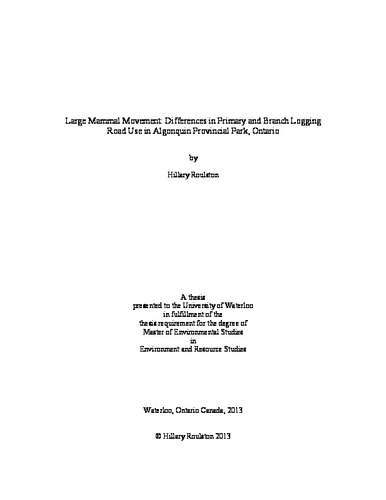| dc.description.abstract | There is an expansive network of roads in Algonquin Provincial Park (APP) to
facilitate forestry resource extraction. This leaves a research need for examining how the
logging road network in APP affects the large mammals, and what local-level and
landscape-level variables influence that use. Local-level data was collected directly at
observation points, and landscape-level data was produced from ArcGIS for 40km2,
80km2, and 130km2 buffer areas. The objective of my study was to look at the use of
primary and branch logging roads by five large mammal species in APP, and determine if
landscape-level variables had an influence on the level of movement and utilization. The
five species included moose, white-tailed deer, American black bear, eastern wolf and
coyote. My null hypothesis (H0) states that there will be no difference in large mammal
use between the primary and branch logging roads within APP and that local- and
landscape-level variables will have no influence on them; my alternative hypothesis (H1)
states that there will be less large mammal activity on the primary logging roads, more
large mammal movement on the branch logging roads and local- and landscape-level
variables will influence this use. Tracking was done by vehicle on six transects across
the park for three repeated surveys where species identification and local-level variables
were recorded. Landscape-level variables were acquired through GIS analysis in the lab.
Based on the results from the local-level data, branch and primary logging road use
differed in composition, though no significance was found between the use by large
mammals for these two types of road. Through generalized linear models, specific
combinations of landscape-level variables did influence large mammal movement on the
primary and branch logging roads within three habitat range scales (130km2, 80km2, and
40km2). The most significance was seen at the buffer of 40km2 on the branch logging
roads, with the variables road density (p < 0.01), percent forest cover (p = 0.04) and
topographic ruggedness (p < 0.01) all having a strong impact on large mammal
movement. The only significant findings for primary logging roads were also at the
40km2 scale with percent forest cover (p = 0.03) and percent water cover (p = 0.02)
having an impact on large mammal movement. Overall, the landscape variables had
greater influence on branch logging roads that may be explained by the quality of the
surrounding habitat, as well as greater influence at smaller buffer scales. Further research
and monitoring of the large mammals in APP is recommended to expand on this
preliminary study. Greater understanding of the local- and landscape-level variables at
differing habitat ranges will assist in understanding these large mammal movements and
provide data to base logging road management on. As large mammals are wide-ranging
species, my study informs APP that their logging road network does not seem to hinder
the movements of this group of animals. Overall, the large mammals in APP did not
have any significant difference in their use of primary and branch logging roads of APP.
Further research has the potential to give greater understanding of the impacts of the
logging road network on the five large mammal species studied in APP. There is also the
potential for useful management strategies to emerge for large mammals in this park, and
how to incorporate human activities within their habitat while maintaining sustainable
populations. | en |

